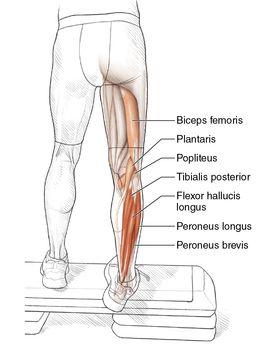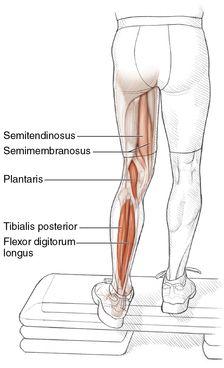Stretching Anatomy-2nd Edition (23 page)
Read Stretching Anatomy-2nd Edition Online
Authors: Arnold Nelson,Jouko Kokkonen
Tags: #Science, #Life Sciences, #Human Anatomy & Physiology

Stretch Notes
Many recreational and even competitive runners suffer from a condition called tendinitis, the chronic inflammation of a tendon. Tendinitis is caused by chronic overuse and tightness of the muscles associated with the affected tendons. The most vulnerable place for this condition in the lower leg is the Achilles tendon. The gastrocnemius and soleus muscles attach to this tendon. If not treated, tendinitis of the Achilles will become excruciatingly painful and will limit your participation in almost any sport activity. Research shows that most people simply don’t spend enough time and effort stretching these muscles. Often it takes a long time (perhaps months) to get rid of this tendinitis. A good stretching program for these muscles should be part of your overall training program.
This stretch is the best for your calf muscles in general.
It is more comfortable to do this stretch while wearing shoes. Always support the body—if the body is not supported, this could cause the muscles to contract and not stretch. After the heels reach their lowest point, apply more stretch by bending the knees slightly. This will stretch the tibialis posterior, flexor hallucis longus, and flexor digitorum longus muscles while reducing the stretch on the hamstring muscles. Placing the ball of the foot on the edge of the stairs or beam will increase the stretch on the origin (top part) of these muscle groups. Placing the midsection of the foot on the edge of the stairs or beam increases the stretch on the lower portion of these muscles.
The sharper the edge of the stair, the better grip you are able to produce between the stair and the foot, and the more stretch you are able to produce on these muscles.
Plantar Flexor and Foot Evertor Stretch
Execution
- Stand upright on the edge of a stair or beam, with the midsection of the right foot on the edge.
- Place the foot in an inverted position by standing on the lateral (outer) side of the foot.
- Keep the right knee straight and the left knee slightly bent.
- Hold onto a support with at least one hand.
- Keeping the foot inverted, lower the right heel as far as possible.
- Repeat this stretch for the opposite leg.
Muscles Stretched
- Most-stretched muscles:
Right peroneus longus, right peroneus brevis, right peroneus tertius, right abductor digiti minimi, lateral side of right soleus, lateral side of right gastrocnemius, right flexor hallucis longus, right tibialis posterior - Less-stretched muscles:
Right popliteus, right plantaris, medial head of right gastrocnemius, right biceps femoris, right flexor digitorum brevis, right quadratus plantae, right flexor digiti minimi brevis, right flexor hallucis brevis
Stretch Notes
Once in a while many of us experience soreness and tightness on the lateral (outer side) of the calf muscles. This could happen any time you walk or run on an uneven or unstable surface, such as grass or beach sand, or walk or run downhill. Often this soreness is felt on the days after the activity. This condition is called delayed-onset muscle soreness, or DOMS. When you encounter this problem, it is highly recommended to start a stretching program, especially of the muscles where this pain is felt. This particular stretch is helpful for the lateral (outer) side of the lower leg.
It is more comfortable to do this stretch while wearing shoes. This is an excellent stretch for the peroneus longus and peroneus brevis and the abductor digiti minimi muscles, which are located on the lateral (outer) side of the lower leg and the foot. Be extra careful when placing the foot in an inverted position, and be sure to progress slowly through this stretching exercise. After the right heel reaches the floor or the lowest point, increase the stretch by bending the right knee slightly. This removes any stretch on the hamstring muscles, but it further stretches the calf muscles.
Plantar Flexor and Foot Invertor Stretch
Execution
- Stand upright on the edge of a stair or beam, with the midsection of the left foot on the edge.
- Place the foot in an everted position by standing on the medial (inner) side of the foot.
- Bend the left knee slightly toward the midsection of the body (inside direction), with the right knee slightly bent.
- Hold on to a support with at least one hand.
- While keeping the foot everted, lower the left heel as far as possible.
- Repeat this stretch for the opposite leg.
Muscles Stretched
- Most-stretched muscles:
Left flexor digitorum longus, left abductor hallucis, medial side of left soleus, left tibialis posterior, left plantaris - Less-stretched muscles:
Left flexor digitorum brevis, left quadratus plantae, left flexor hallucis brevis, left flexor digiti minimi brevis, left medial gastrocnemius, left semitendinosus, left semimembranosus
Stretch Notes
Shin splints are a nuisance for many endurance exercisers. This condition is often caused by overuse or tightness of the plantar flexor and invertor muscles. It is very hard to do any sport activities with the constant pain from shin splints. This stretch particularly stretches the flexor digitorum longus and the medial aspect of the soleus muscles. People with this problem will definitely benefit from this stretch. Also evaluate shoes as well as the running and walking surfaces. In addition, a thorough stretching program should be included in any rehabilitation program.
It is more comfortable to do this stretch while wearing shoes. This is an excellent stretch for the flexor digitorum longus, medial soleus, and abductor hallucis muscles, which are located on the medial side of the lower leg and foot. Take extra care when placing the foot in an everted position, and be sure to progress slowly through the stretch. After the left heel reaches the floor or the lowest point, bending the left knee slightly can increase the stretch. This reduces the stretch on the hamstring muscles, but it increases the stretch on the flexor digitorum longus, medial soleus, and abductor hallucis muscles.
Chapter 8
Dynamic Stretches
Flexibility is an important component of physical fitness. Generally speaking, people with greater flexibility have better performances and reduced risk of injury. Consequently, many athletes include stretching exercises designed to enhance flexibility in both their training programs and preevent warm-up activities.
Since the late 1990s, however, several researchers have questioned the purported benefits of stretching. Numerous studies have established that preevent static stretching can inhibit almost all components of performance. For instance, preevent static stretching can reduce maximal strength, vertical jump performance, running speed, and muscular endurance. In addition, several recent research studies have failed to establish a link between preevent static stretching and injury prevention. In fact, a few studies have demonstrated that athletes with high levels of flexibility are more likely to suffer injuries than those with moderate flexibility. Some evidence shows that extremely tight people are less likely to experience muscle strains, but it is speculated that if preevent static stretching is reducing this type of injury, it is due to its ability to reduce the overall strength of the muscle. Strains, pulls, and tears happen when a muscle is forcefully contracted, so by reducing the force output you are less likely to cause injury. Finally, it is important to note that although many studies show the lack of benefits of preevent static stretching, there is still much evidence to support the benefits of static stretching after a workout.
Dynamic stretching is gaining popularity because of the complications that can arise from traditional preevent static stretching. As was discussed in the introduction, the muscle spindle proprioceptors have a fast dynamic component and a slow static component that provide information on not only the amount of length change but also the rate of length change. Fast length changes can trigger a stretch, or myotatic, reflex that attempts to resist the change in muscle length by causing the stretched muscle to contract. Slower stretches allow the muscle spindles to relax and adapt to new, longer lengths. Thus, dynamic activities that require quick, forceful movements, such as running, jumping, or kicking, utilize the dynamic receptor to limit flexibility. Consequently, researchers started to investigate whether a dynamic stretch that activates the dynamic receptor would be more beneficial when preparing to perform dynamic activities.
Dynamic stretching uses swinging, jumping, or exaggerated movements so that the momentum of the movement carries the limbs to or past the regular limits of the range of motion and activates a proprioceptive reflex response. The proper activation of the proprioceptors can cause facilitation of the nerves that activated the muscle cells. This facilitation enables the nerves to fire more quickly, thus enabling the muscle to make fast and more powerful contractions. Hence, it can prepare the muscles and joints in a more specific manner since the body is going through motions it will likely repeat in the workout. It also helps the nervous system since dynamic motions do more to activate this aspect than static stretching does. Since dynamic stretching also includes constant motion throughout the warm-up, it maintains core body temperature, while static stretching can result in a drop in temperature of several degrees.
Research using dynamic stretching that controls movement through a joint’s active range of motion has shown an increase in power performances such as sprinting and jumping. Moreover, there have been no reports of adverse effects on performance from either short or long sessions of dynamic stretching. For instance, one study showed that performance improved when dynamic stretches lasted more than 90 seconds, with little or no change for shorter stretch times. Additionally, a few research studies have shown that the negative impact of static stretching may be reduced or eliminated if dynamic stretches are done after static stretches. Thus, it is now highly recommended that a person perform dynamic stretches just before engaging in any activity.
As for any other activity, you must follow specific guidelines and principles when performing dynamic stretches:
- An effective warm-up that includes dynamic stretches should last 10 to 15 minutes or 10 to 20 repetitions.
- Observe your initial body position when you do a particular activity, and then make sure you start the dynamic stretch from the same initial position.
- Note the range of motion that each joint travels. The dynamic stretch should not greatly exceed the range of motion of the activity for which you are preparing. No bouncing.
- The dynamic stretch should closely replicate the movements used during the activity. Use good technique and be sure to use all of the muscles normally used during the activity. If the dynamic stretches mimic a specific sport skill such as a high knee lift, the stretches should utilize the specific factors of the skill. If you are careful to mimic the skill as closely as possible, you enhance the learning of the skill specificities and diminish the chances of introducing improper techniques.
- When doing dynamic stretches, you can either perform repetitions in the same place or travel for a set distance. Whether you remain in place or move, you should start each stretch slowly and progressively increase the range of motion and movement speed with each repetition. For instance, if you are moving over a distance, start with a walk, proceed to a skip, and finally end with a run.
- Dynamic stretches can be done singularly or in combination. Combining two or more stretches provides variety in your program and enables you to better mimic more complex skills.


